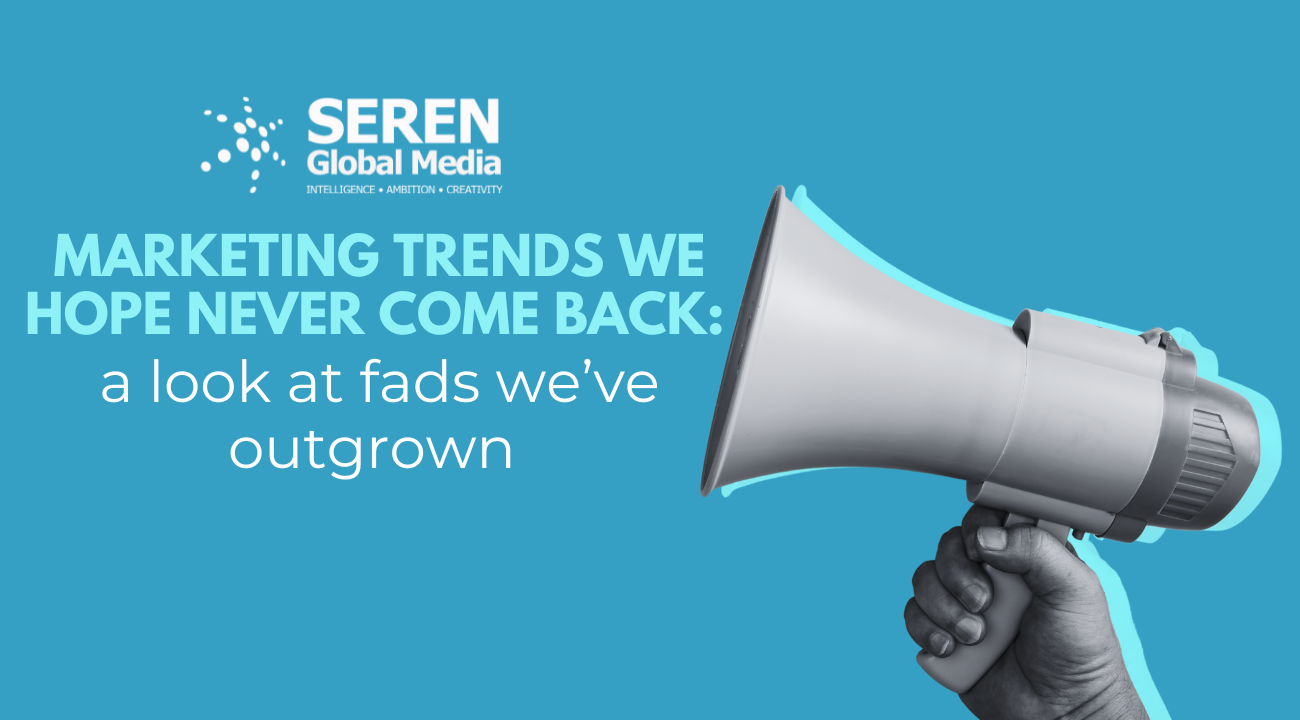Marketing trends we hope never come back: a look at fads we’ve outgrown

Marketing trends we hope never come back: a look at fads we’ve outgrown Marketing is never stagnant, its changing all the time! Just like fleeting hairstyles and passing slang fads, marketing trends come and go, sometimes leaving behind a trail of questionable tactics and outdated practices. While some trends have become timeless classics, others are best left in the past. In this blog, we’re looking back at some of the most memorable marketing fads that we’re glad are no longer in vogue.
Flashy website introductions
Remember the days when landing on a website meant enduring a flashy, often blinding introduction with animations, sound effects, and a ‘skip intro’ button?
Why it was popular: Websites aimed to make a dramatic first impression with elaborate graphics and animations to capture visitors’ attention.
Why it faded: These introductions were often more annoying than engaging, causing higher bounce rates and frustrating users who just wanted to access content quickly.
Modern equivalent: Today’s websites focus on user experience with clean designs and fast load times. Animations are now used sparingly and strategically.
Keyword stuffing
In the early days of SEO, websites would cram as many keywords as possible into their content, often resulting in awkward and unreadable text, making the content search engine friendly but unpleasant for readers.
Why it was popular: Marketers believed that stuffing keywords into content would improve search engine rankings and drive more traffic.
Why it faded: Search engines became more sophisticated and penalised websites for keyword stuffing, prioritising high-quality, relevant content instead.
Modern equivalent: SEO now emphasises natural language, user intent, and providing valuable content over keyword density.
Spammy email blasts
We’ve all received over-the-top email blasts with misleading subject lines and excessive promotional content, which are destined to be ‘archived’.
Why it was popular: Email marketers used aggressive tactics to capture attention and drive conversions.
Why it faded: These spammy tactics led to poor user experiences, high unsubscribe rates - achieving the opposite to the desired effect!
Modern equivalent: Today’s email marketing focuses on personalised, targeted messages with clear value and respect for subscribers’ preferences.
The rise and fall of QR codes
QR codes were once heralded as the next big thing in bridging offline and online experiences.
Why it was popular: QR codes provided a quick way to access digital content using smartphones.
Why it faded: Early adoption faced technical issues, and QR codes were often underutilised or placed in inconvenient locations.
Modern equivalent: QR codes have seen a resurgence with improved technology and practical applications in areas like contactless payments and digital menus.
Overly aggressive pop-ups
Pop-ups that interrupted user experience with multiple layers of promotions or newsletter sign-ups were once common - however, incredibly unpopular with users.
Why it was popular: Pop-ups were used to capture leads and drive conversions by demanding immediate attention.
Why it faded: Users found them intrusive and disruptive, leading to higher bounce rates and very negative perceptions of brands.
Modern equivalent: Effective lead capture now uses less intrusive methods like exit-intent pop-ups and in-content prompts.
Our team at Seren Global media are dedicated to helping businesses adapt and avoid the difficulties of outdated trends. In need of strategy advice? Contact us today!
Archive
2024 (16)
September (1)
August (1)
July (2)
June (1)
May (2)
April (3)
March (2)
February (1)
January (3)
2023 (27)
December (1)
November (3)
October (3)
September (2)
August (4)
July (2)
June (3)
May (1)
April (2)
March (3)
February (3)
2022 (21)
December (3)
November (1)
October (2)
September (3)
August (1)
July (2)
June (1)
May (1)
April (1)
March (2)
February (1)
January (3)
2021 (25)
December (2)
November (1)
October (3)
September (2)
August (2)
July (2)
June (3)
May (2)
April (2)
March (2)
February (2)
January (2)
2020 (20)
December (2)
November (3)
October (1)
September (2)
August (1)
July (2)
June (1)
April (2)
March (2)
February (2)
January (2)
2019 (22)
December (2)
November (2)
October (2)
September (3)
August (3)
July (2)
June (2)
May (2)
April (3)
January (1)
Latest News/Blog
Marketing trends we hope never come back: a look at fads we’ve outgrown
03 September 2024